
* In the 1950s, the Pascale brothers of Naples established a civil aircraft firm named "Partenavia", which produced a series of aircraft up to the "P.68" light twin. Partenavia would eventually be bought out by the Vulcanair company, which would introduced a turboprop derivative, the"AP.69TP". The Pascale brothers had left Partenavia well before the buyout, to form the "Tecnam" company of Capua, which produced light singles, starting with the "P92 Echo", leading up to the "P2006T" light twin, and the larger "P2012 Traveler". This document provides a history and description of Partenavia and Tecnam aircraft. A list of illustration credits is included at the end.
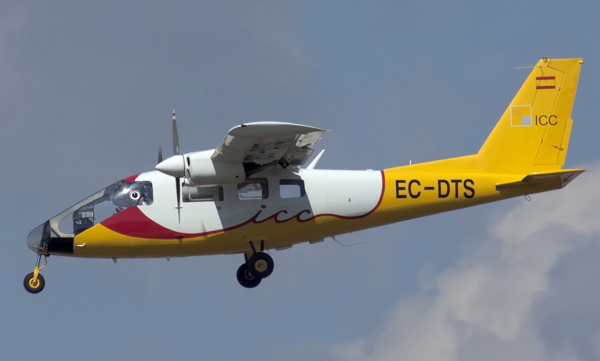
* In the postwar period, Luigi "Gino" Pascale and his brother Giovanni "Nino" Pascale of Naples, Italy, having been enthusiastic flying model aircraft makers, decided to work on full-scale aircraft. The first, built while the brothers were college students, was the "P.48 Astore (Goshawk)" -- a two-seat aircraft, with the seats in tandem, featuring a high strut-braced wing, fixed taildragger landing gear, and a Continental O-170 / A65 flat-four air-cooled engine with 48 kW (65 HP).
One Astore was built, performing its initial flight in 1952 -- by which time Luigi Pascale had become an instructor in mechanical engineering at Naples University, where he would become a full professor and help establish a department of aeronautical engineering. The Astore was followed by other one-off designs:
The "P.57 Fachiro" -- "Fachiro" translating directly as "fakir", though that doesn't sound quite right, possibly the name was an inside joke -- was Pascale's first production machine, introduced in 1958 by the Partenavia firm, which the Pascales had set up the year before to mass-produce their aircraft. Luigi Pascale's would come to respectfully call him "il Professore".
The P.57 was a touring aircraft of conventional configuration, with a high braced wing, four seats, forward-hinged doors on each side, fixed tricycle landing gear, of mixed steel tube / fabric construction. The first machine, the "Fachiro I" was powered by a Lycoming O-320 with 112 kW (150 HP); it was followed by three "Fachiro II" machines with an O-360-B2A engine with 125 kW (168 HP), and then 33 "Fachiro IIf" machines, with an O-320-A2A engine providing 134 kW (180 HP).
Partenavia's next effort was the "P.59 Jolly (Joker)", a two-seater something along the lines of a scaled-down P.57, but with fixed taildragger landing gear and a Continental O-200 flat-four engine with 75 kW (100 HP). It was designed in response to a competition for a trainer for the Italian Aero Club -- but the P.59 lost to the Aviamilano P.19 Scricciolo, and the P.59 remained a one-off.
The P.57, however, was successful enough to consider a rethought version of all-metal construction, with the "P.64 Fachiro III" taking to the air for the first time on 2 April 1965. After some rethinking of the prototype design, mostly to add a rear window and a cut-down rear fuselage, it went into production as the "P.64B Oscar B" -- the "Oscar" effectively meaning "Type O" -- to then be renamed the "P.64B Oscar 180".
The Oscar 180 was of very similar configuration to the original Fachiro, being a four-seat aircraft with a high braced wing and fixed tricycle landing gear. It was designed with low cost, sturdiness, and ease of maintenance in mind. It was powered by a Lycoming 0-360-A1A engine with 135 kW (180 MPH), driving a two-blade Hartzell propeller. It had three front-hinged doors, with two on the right side -- it is unclear if the P.57 had the third door as well. 64 Oscar 180s were built; there was also an "Oscar 200", with O-360-A1B engine providing 150 kW (200 HP), with nine built. 21 were also delivered in breakdown kits to AFIC (PTY) LTD of South Africa for assembly, to be marketed as the AFIC "RSA 200 Falcon".
___________________________________________________________________
PARTENAVIA P.64B OSCAR 180:
___________________________________________________________________
wingspan:
9.99 meters (32 feet 9 inches)
wing area:
13.4 sq_meters (144.2 sq_feet)
length:
7.23 meters (23 feet 9 inches)
height:
2.77 meters (9 feet 1 inch)
empty weight:
670 kilograms (1,477 pounds)
MTO weight:
1,155 kilograms (2,546 pounds)
cruise speed:
240 KPH (149 MPH / 130 KT)
service ceiling:
5,300 meters (17,400 feet)
range:
1,200 kilometers (745 MI / 648 NMI)
take-off distance (to 15 meters / 50 feet):
245 meters (804 feet)
landing distance (from 15 meters / 50 feet):
200 meters (656 feet)
___________________________________________________________________
Partenavia then developed a "lightweight" Oscar, the "P.66B Oscar 100", by the simple trick of cutting out a slice of the cockpit and only fitting it with two seats, reducing length by 14 centimeters (5.5 inches) and empty weight by 110 kilograms (242 pounds). It was powered by an O-320 engine with only 75 kW (100 HP); 80 were built. The "P.66B Oscar 150" had the same spliced-out fuselage as the P.66B Oscar 100, but with a third seat crammed in, and a 112 kW (150 HP) Lycoming engine; 50 were built.
The "P.66C Charlie" was an update of the original full-length P.64 Oscar series, with four seats. It was fully aerobatic, though it was powered by a 120 kW (160 HP) Lycoming engine, giving it less pep than the Oscar 180. However, its empty weight was 70 kilograms less than that of the Oscar 180, meaning it could get by with a less powerful engine. 96 were built.
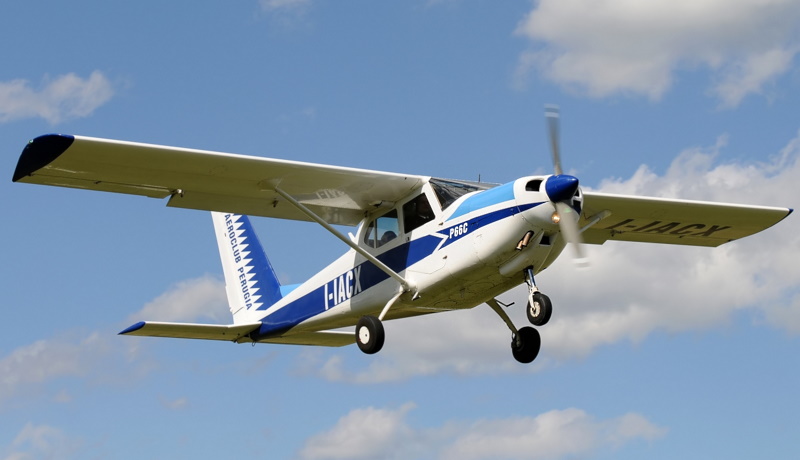
That was effectively the end of the line. A single "P.66D", an improved P.66B, was built, but did not go into production. There was also a single "P.66T", which was a trainer version of the P.66C Charlie. That gave total production of the P.64 / P.66 as 1 + 64 + 9 + 21 + 80 + 50 + 96 + 2 = 323 machines.
BACK_TO_TOP* Following the P.64 / P.66, Partenavia went on to develop a twin-engine civil aircraft -- which would emerge as the "P.68 Victor", the "Victor" meaning effectively "Type V". Initial flight was on 25 May 1970, with 13 early production / pre-production aircraft following from 1972, three of them configured for aerial survey. Following the pre-production aircraft, in 1974 Partenavia introduced the "P.68B", which featured a fuselage stretch of 15 centimeters (6 inches) to provide more room in the cockpit.
The P.68B provides a useful baseline for the series. As it emerged, the P.68B was a clean, straightforward high-wing twin-piston aircraft focused on simplicity of design, though it was distinctly smaller. It was made mostly of aircraft aluminum alloy, with some use of composite materials. It featured a straight wing; a piston engine on each wing; fixed tricycle landing gear, the main gear on struts extending from the fuselage; and a shark-like forward fuselage with no cockpit step.
The tailplane was rectangular, with triangular forward fillets; the tailfin was swept, with a modest forward fillet. Flight control surfaces were conventional -- ailerons, single-piece slotted flaps, elevators, rudder, plus trim tabs -- and manually actuated, except for electrically-driven flaps.
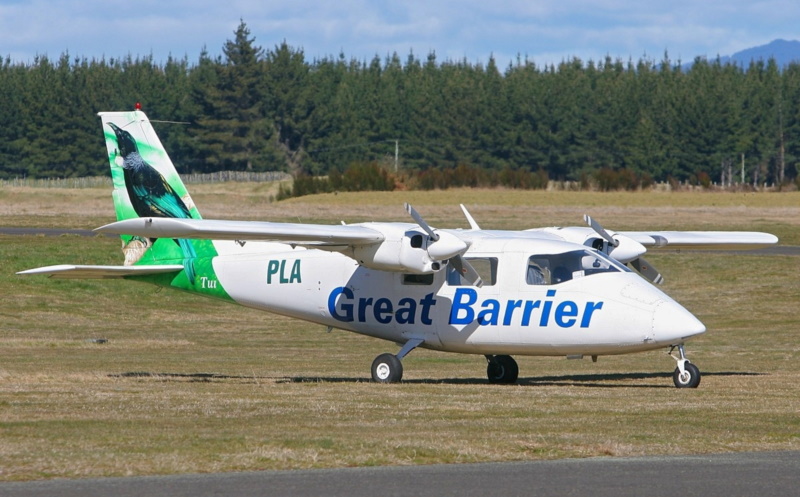
The P.68B was powered by twin flat-four air-cooled Lycoming IO-360 engines with 150 kW (200 HP) each, driving two-bladed constant-speed feathering Hartzell propellers. There was a fuel tank in each wing, with a refueling point on top of each wing, total fuel capacity being 410 liters (108 US gallons). Wing and tail pneumatic de-icing boots were optional, as were electrothermal prop de-icing and alcohol windshield de-icing.
The P.68B had six seats, including the pilot seat, in three rows of two, the front seats sliding, with access from a forward-hinged door on the left side of the fuselage. There was a baggage storage area to the rear of the seats, with a baggage door on the right. Somewhere along the line a "club" interior was introduced, with the last two rows of seats facing each other and with a folding table between them. The P.68B was unpressurized; it had a cabin heater, but no air conditioning. Dual controls were standard, while cockpit avionics were conventional for light civil machines of the era. An option was available for mounting a survey camera, shooting through the floor. 190 P.68Bs were built.
One P.68B with retractable undercarriage was flown; it may have been a conversion. Another P.68B was kitted up with floats -- but it doesn't appear that Partenavia ever sold the P.68 with floats. Floats could be obtained as after-market accessories, but photo searches suggest that there were a few P.68 floatplanes.
* The P.68B was followed in turn in 1979 by the "P.68C", which had a longer nose with weather radar, providing a slight cockpit step that distinguished it from its shark-nosed predecessor; it also had a third window on each side of the fuselage, under the wing trailing edge, and fuel supply increased to 520 liters (137 US gallons). A "P.68C-TC" with Lycoming TI0-360-C1A6D turbocharged engines, providing 150 kW (200 HP) each, was introduced in 1980. At least 114 P.68Cs were built, it being unclear if this total includes P.68C-TCs. The P.68C also led to a variant with retractable landing gear, the "P.68R".

The German company Sportavia-Puetzer replaced the front fuselage of the P.68 with a new front fuselage featuring extensive glazing, with P.68s converted to the configuration and marketed under the name of "Observer", the primary customer being seen as law enforcement. Eventually, Partenavia began to build Observers themselves.
___________________________________________________________________
PARTENAVIA (VULCANAIR) P.68C:
___________________________________________________________________
wingspan:
12 meters (39 feet 4 inches)
wing area:
18.6 sq_meters (200.23 sq_feet)
length:
9.55 meters (31 feet 4 inches)
height:
3.4 meters (11 feet 2 inches)
empty weight:
1,420 kilograms (3,130 pounds)
MTO weight:
2,085 kilograms (4,595 pounds)
cruise speed:
300 KPH (185 MPH / 160 KT)
service ceiling:
6,020 meters (19,750 feet)
range:
2,045 kilometers (1,270 MI / 1,130 NMI)
take-off distance (to 15 meters / 50 feet):
400 meters (1,310 feet)
landing distance (from 15 meters / 50 feet):
600 meters (1,970 feet)
___________________________________________________________________
An "Observer 2" was introduced in the late 1980s, featuring 100 liters (26.4 US gallons) more fuel capacity in the wings; larger tires; a redesigned interior; avionics updates, particularly a glass cockpit; and upturned wingtips for better low-speed handling. The Observer 2 had a belly compartment for a camera or other payload. It is unclear if the compartment was also featured in the Observer 1, and also unclear how many Observers were built.
Partenavia went bankrupt in the mid-1990s. Late in the game, Partenavia tried to arrange for manufacture of the company's aircraft by the TAAL firm of India, but it seems the exercise might, at most, involved assembly of a few aircraft from Partenavia-supplied kits. Partenavia was bought out in 1996 by Vulcanair, a parts supplier. The P.68C and P.69TC remain in production -- with the upturned wingtips of the Observer 2 as standard -- as does the P.68R, sold as the "Vr". The Vr is not available with turbocharged engines, and does not have the upturned wingtips.
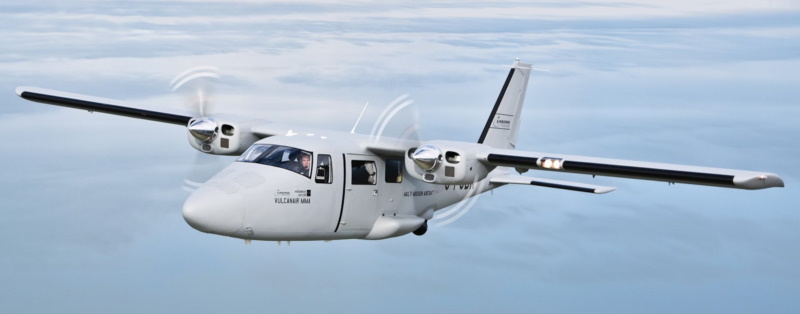
Vulcanair sells the Vr for special missions as the "Multi-Mission Aircraft (MMA), with an imaging turret or other sensor mounted on the belly behind the main landing gear, and provision for two workstations. The Observer 2 also continues to be sold, with turbocharged engines as an option, presumably with similar options to the MMA.
BACK_TO_TOP* Partenavia / Vulcanair has also developed turboprop-powered aircraft. In 1978, Partnavia flew a P.68 with twin Allison 250 turboprop engines, Aeritalia having assisted in development, resulting in the prototype "AP.68TP Spartacus", with nine seats. It was followed by a second prototype, the "AP.68TP-100", leading to the initial production "AP.68PT-300 Spartacus". Although the two prototypes had retractable landing gear, the AP.68PT-300 had fixed landing gear.
Only 13 AP.68TP-300s were made, with the production then moving on to the "AP.68TP-600 Viator (Wanderer)" -- a stretched machine with a longer nose and retractable undercarriage, with a capacity of nine passengers, plus pilot and copilot. It appears that only a small number were built before Partenavia went broke.
In 2009, Vulcanair revived the type in the form of the "AP.68TP A-Viator", the primary change being updated avionics. As introduced, the A-Viator had Allison / Rolls Royce 250-B17C turboprops with 245 kW (328 SHP), driving three-bladed Hartzell constant-speed / reversible props. The wing was of the same configuration as the P.68C; the tailfin was similar, if enlarged, but the tailplane was of different configuration, with a tapered leading edge. Fuel was stored in two tanks in each wing, plus a tank in each engine nacelle, total fuel capacity being 840 liters (222 US gallons). All landing gear assemblies had single wheels, the nose gear retracting forward, the main gear tucking sideways into sponsons.
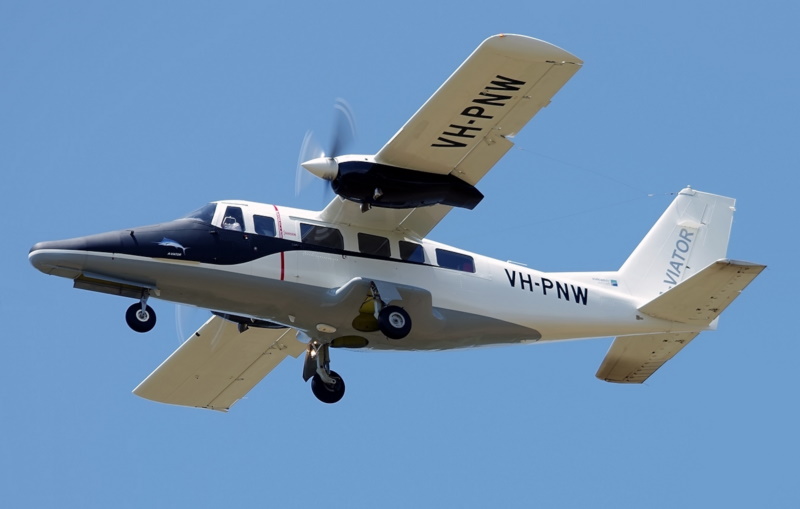
The A-Viator could carry one or two pilots, or 9 or 10 passengers, the seats being on rails for easy installation, adjustment, or removal. A combi configuration had six passenger seats; of course, full cargo operation or paradropping was also offered, as was an air ambulance with two stretchers and seats for two attendants. There was a cockpit door and a passenger door on each side, with a double passenger / cargo-loading door on the right side. The A-Viator had a Garmin glass cockpit; optional weather radar was in a nose thimble.
___________________________________________________________________
VULCANAIR AP.68TP-600 A-VIATOR:
___________________________________________________________________
wingspan:
12 meters (39 feet 4 inches)
wing area:
18.6 sq_meters (200.23 sq_feet)
length:
11.27 meters (37 feet)
height:
3.63 meters (11 feet 11 inches)
empty weight:
1,680 kilograms (3,705 pounds)
MTO weight:
3,000 kilograms (6,600 pounds)
cruise speed:
395 KPH (245 MPH / 215 KT)
service ceiling:
7,620 meters (25,000 feet)
range:
1,740 kilometers (1,080 MI / 940 NMI)
take-off distance (to 15 meters / 50 feet):
640 meters (2,100 feet)
landing distance (from 15 meters / 50 feet):
700 meters (2,300 feet)
___________________________________________________________________
Vulcanair has also promoted a coastal patrol / SAR variant, the "Marlin", with search radar, an imaging turret under the nose, stores pylons, belly hatches, and parachutable life raft / rescue kits. Of course the A-Viator could also be used for other special missions. Vulcanair continues in business -- one high-profile sale having been of seven Observer 2 machines to Chile in 2015, for littoral patrol and SAR.
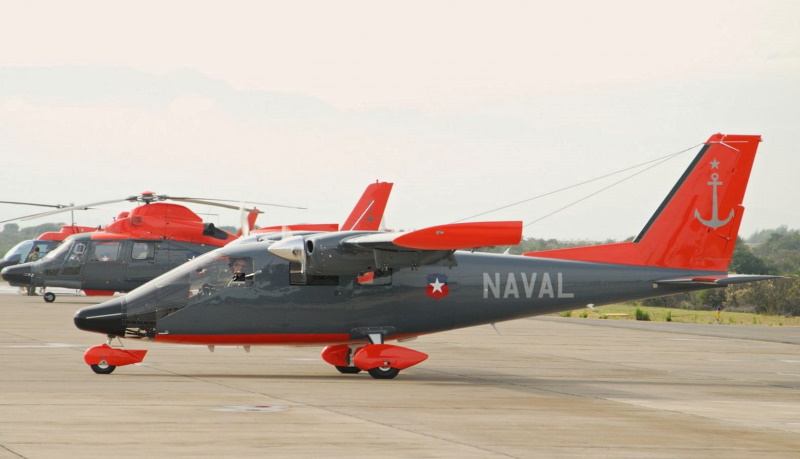
* Vulcanair has also attempted to sell a larger twin-turboprop machine, the "Canguro (Kangaroo)". It had originally been designed by SIAI-Marchetti engineer Stelio Frati in the 1970s with piston propulsion, performing its first flight on 30 December 1978. In 1981, SIAI-Marchetti introduced the "SF-600A Canguro", with turboprop engines, retractable landing gear, and options for a sliding door or hinged rear fuselage.
A choice of fixed or retractable undercarriage versions was available, the engines being 335 kW (450 SHP) Allison 250-B17F turboprops. The baseline utility version could have a dozen passenger seats, or four stretchers for the air ambulance role. It could also be used for paradropping, photo survey, or target / glider tow. Military versions were projected, including a swing-tail cargo transport; an electronic warfare aircraft; and a maritime surveillance variant, with an undernose search radar. The military variants were to feature two under-wing and two underfuselage hardpoints.
Only ten Canguros were made, with Vulcanair acquiring rights in 1997. Vulcanair hasn't been able to do much with it either -- but the firm did work on a single-engine derivative, the "VF600W Mission", along the lines of a modestly scaled-up Cessna Caravan, featuring a braced high wing and fixed tricycle landing gear. Initial flight was on 4 December 2002, the aircraft being powered by a Walter M691F-11 turboprop with 580 kW (780 SHP), driving a five-blade propeller. That was about as far as it went, the program slowly fading out of existence.
Incidentally, Vulcanair also revived the P.64 Oscar single as the "V.10". It was the same airframe, but it was given refinements -- most notably advanced avionics, organized around a Garmin G500 glass cockpit. Apparently it's still on offer.
BACK_TO_TOP* The Pascale brothers were no longer with Partenavia when it went bust, to be picked up by Vulcanaire. For whatever reasons, they left Partenavia in 1986, to found a new aircraft company named "Tecnam". The new company's first design was the "P92 Echo", a two-seat lightweight machine with a high braced wing and fixed tricycle landing gear. It appears to have been a design that Luigi Pascale had sketched out over a quarter-century before, being conceptually along the lines of the one-off P.59 Jolly, being intended primarily as a basic trainer.
The P92 performed its first flight on 14 March 1993. As introduced, it was a simple, straightforward design; it featured mixed construction, with the cockpit being based on a steel-tube frame covered by metal sheeting, a stressed-skin rear fuselage, a composite engine cowling with quick-release latches; and metal flight surfaces, except for a composite wing leading edge, plus polymer cloth covering on the ailerons and the rear of the tailplane. It had side-by-side seats, with a forward-hinged door on each side. There was a baggage space behind the seats; dual controls were standard.
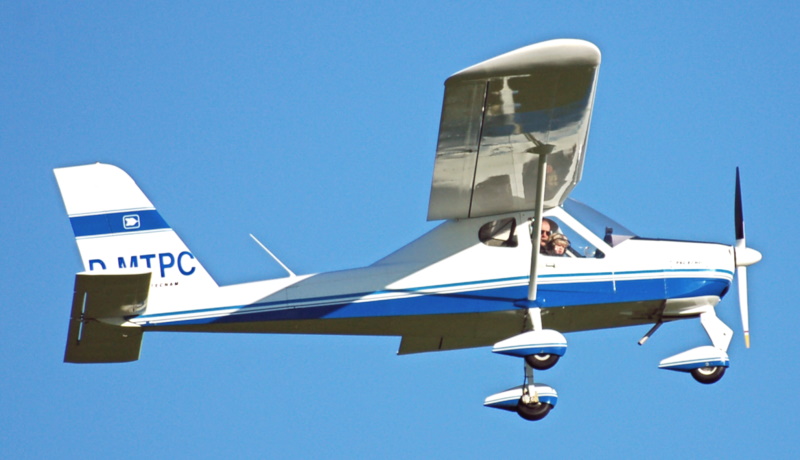
Flight control surfaces were of conventional configuration, except for an all-moving tailplane. The Echo was designed to be easily broken down for kit assembly, or for transport. It had side-by-side seats, dual controls, and a front-hinged door on each side. Typical powerplant was a Rotax flat-four water-cooled engine, with a number of engine options, see below, driving a two-bladed prop. There was a fuel tank in each wing, total capacity being of 60 liters (15.8 US gallons).
___________________________________________________________________
TECNAM P92 ECHO:
___________________________________________________________________
wingspan:
9.6 meters (31 feet 6 inches)
wing area:
13.2 sq_meters (142.1 sq_feet)
length:
6.3 meters (20 feet 8 inches)
height:
2.49 meters (8 feet 2 inches)
empty weight:
282 kilograms (622 pounds)
MTO weight:
520 kilograms (1,146 pounds)
cruise speed:
185 KPH (115 MPH / 100 KT)
service ceiling:
4,000 meters (13,000 feet)
range:
740 kilometers (460 MI / 400 NMI)
take-off distance (to 15 meters / 50 feet):
110 meters (360 feet)
landing distance (from 15 meters / 50 feet):
100 meters (328 feet)
___________________________________________________________________
The P92, in the course of its long product development, has been offered with a range of engine and other options, the result being a confusing "Chinese menu" of model designations. It is extremely difficult, and not particularly rewarding, to sort the different subvariant designations -- all the more so because these designations have followed an irregular pattern. Options have included, at various times in the history of the P92 series:
There were various minor options to confirm to different European and American standards for light / ultralight aircraft. They were all basically the same aircraft, just with minor tweaks. There was also the "Seasky" option, specifying a seaplane variant with floats, amphibian wheels being optional. It had a fin under the tail to provide yaw compensation for the floats, and was only offered with the 100 engine option.

There was also a "P92 Echo Light", a low-cost, reduced-weight machine with the 8.7-meter wingspan. It was only available with the 80 engine option.
* A second generation of P92s was introduced in 1999, in the form of the "P92-S". The "S" was for "Super", which made a handy if unofficial name for the series to distinguish it from the original Echo. It featured considerable airframe tweaks, including a wing with a redesigned profile; a redesigned engine cowling, a bulged windscreen; two windows to the rear of each of the doors, not just one; and a small forward fillet on the tailfin. It was available with a range of options like the original P92 Echo, including the Seasky.
A "P92 2000RG" was introduced in 2000, which was the P92-S with retractable landing gear, the fuselage being widened by 4 centimeters (1.5 inches) to accommodate the gear. The nose gear retracted backward, the main gear hinged from stub wings on each side of the fuselage to retract inward; there were no covers over the main gear wheels. The wing struts were connected to the ends of the stub wings. It had the 8.7-meter wing.

The 2000RG did not prove popular; its performance specs were similar to those of the P92-S, which suggests that it simply cost more without providing any real benefit. It was discontinued. The Super series remains in production as the "P92 JS", which features the 8.7-meter wing, a traditional avionics fit, and the 100 engine option.
* A third generation, the "P92 Eaglet", was introduced in 2008. It looked much like the Super, but had various tweaks -- most notably, the two windows behind each door being merged into one, providing a distinctive recognition feature. Wingspan was 8.7 meters. It was offered with a range of options, including the Seasky configuration, and could be ordered with a Garmin or Dynon glass cockpit, instead of the default traditional control layout. The baseline P92 Eaglet remains on offer, with the 100 engine option -- either Rotax or Lycoming -- and in LSA configuration. There's also a "P92 Classic" on offer, which appears to be a low-cost Eaglet, with the 80 or 100 engine option, a 9.6-meter wing, and traditional cockpit layout.
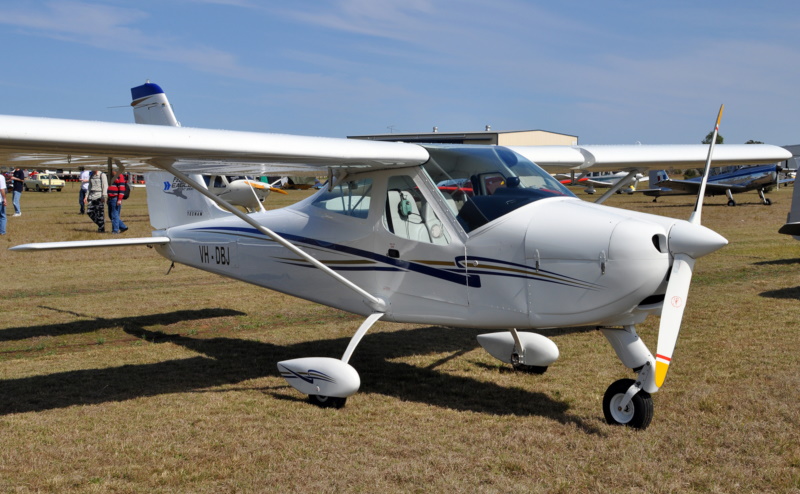
In 2012, Tecnam introduced a variant with taildragger landing gear -- designated, of course, "P92-TD", it seems primarily for the US sport market. It had a glass cockpit and could be fitted with a belly pannier for baggage. It is unclear if it could be fitted with "fat tires" for rough-field operation. It was available with turbocharged Rotax engines as an option.
Both the P92 JS and the P92 Eaglet are available with the "SmartBay" option, which permits mounting an underwing sensor payload, with wiring for cockpit control via a small display mounted low on the center dashboard.
In 2020, Tecnam introduced the "P92 Echo Mark II", featuring more cabin volume; wider seats; better seat adjustment fore and aft; an optional ballistic parachute, and touchscreen Garmin flight deck with synthetic vision and ground proximity alerts. It is available in a number of configurations to meet different classifications for light / ultralight aircraft.
BACK_TO_TOP* Working from the Super version of the P92, Tecnam went on to build a derivative that was generally similar in configuration, but featured a cantilevered instead of strut-braced wing. Initial flight of the "P2004 Bravo" was in 2002.
The P2004 was made primarily of aircraft aluminum alloy, being powered by a Rotax 912 ULS engine, driving a Tonini two-blade fixed-pitch prop. It apparently had design features, and some assemblies, in common with the low-wing P2004 Sierra, see below.
___________________________________________________________________
TECNAM P2004 BRAVO:
___________________________________________________________________
wingspan:
8.4 meters (27 feet 6 inches)
wing area:
11 sq_meters (118.4 sq_feet)
length:
6.61 meters (21 feet 8 inches)
height:
2.6 meters (8 feet 6 inches)
empty weight:
330 kilograms (730 pounds)
MTO weight:
600 kilograms (1,320 pounds)
cruise speed:
215 KPH (130 MPH / 115 KT)
service ceiling:
4,000 meters (13,000 feet)
range:
1,090 kilometers (675 MI / 590 NMI)
take-off distance (to 15 meters / 50 feet):
140 meters (460 feet)
landing distance (from 15 meters / 50 feet):
120 meters (395 feet)
___________________________________________________________________
* The P2004 was followed in 2009 by the "P2008", which is of the same general configuration as its predecessors -- single-engine two-seater with fixed tricycle landing gear -- but reverted to a strut-braced wing, and was something of an innovation for Tecnam: it had a fuselage of carbon composite construction, with an integral fin. The wings and tailplane were of metal construction.
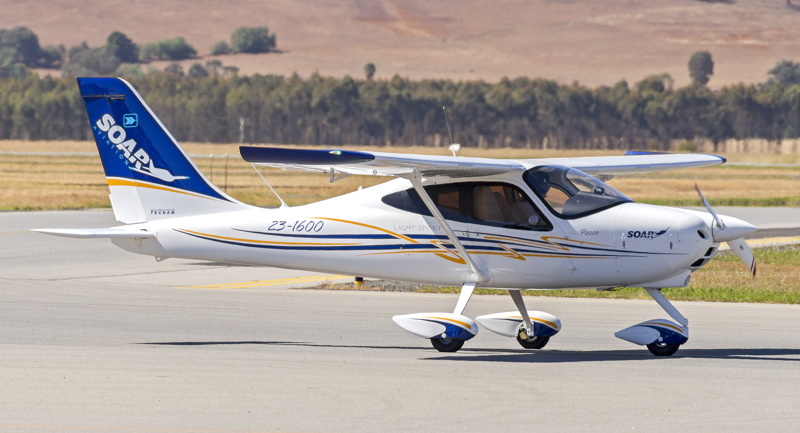
First flight was on 30 September 2008, with initial deliveries in 2009. It is powered by a Rotax 912ULS engine with 75 kW (100 HP), driving a two-bladed propeller, with a fuel supply of 110 liters (29 US gallons). It wasn't that much bigger than a P92 Echo, with an empty weight of 354 kilograms (780 pounds), an MTO weight of 600 kilograms (1,323 pounds), a length of 6.93 meters (22 feet 9 inches) and a wingspan of 8.8 meters (28 feet 10 inches). Along with the baseline version, two subvariants were introduced:
* Following the P2008 in turn, in 2012 Tecnam introduced the "P2010", which was effectively an enlarged P2008 with four seats, in a 2x2 arrangement. Initial flight was on 12 April 2012. As introduced, like the P2008 it had a composite fuselage, with metal wing and tailplane. It had spatted tricycle landing gear, and was powered by a Lycoming IO-360-M1A flat-four air-cooled engine, providing 135 kW (180 HP) and driving a two-bladed MT Propeller prop.
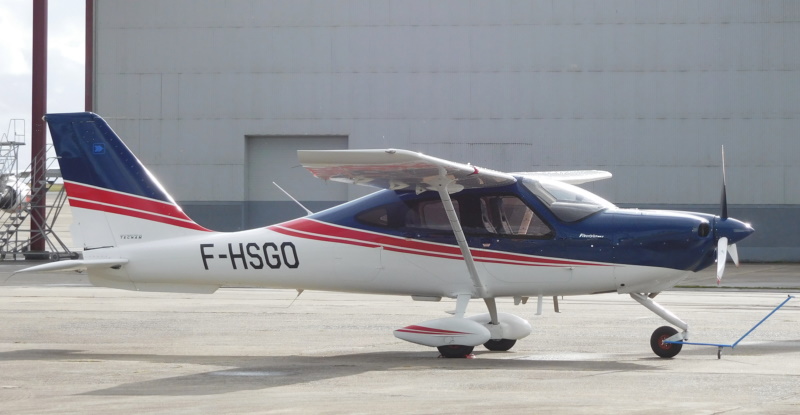
Fuel capacity was 210 liters (55.5 US gallons), giving a range of 1,220 kilometers (760 miles / 660 NMI). The P2010 had three forward-hinged doors -- two on the right side of the fuselage, one forward on the left. Length was 7.54 meters (24 ft 9 inches); wingspan was 10.5 meters (34 feet 5 inches); empty weight was 710 kilograms (1,565 pounds), while MTO weight was 1,160 kilograms (2,557 pounds).
The "P2010 Gran Lusso (Great Luxury)" was introduced in 2022. As its name implied, it was fitted with a new luxury interior. It was powered by a Continental CD-170 turbo-diesel (multi-fuel) engine, proving 125 kW (170 HP). Tecnam has worked on a hybrid-electric demonstrator based on the P2010, with a Rotax engine generating power for two electric motors, and also explored a purely electric machine.
BACK_TO_TOP* While Tecnam was producing the high-wing series of light singles, the company was also selling a series of low-wing light singles. The P92 having proven successful, Tecnam decided to develop another little two-seater, the "P96 Golf". It performed its first flight in 1996, with introduction in 1997. Unlike the P92, the P96 was a low-wing aircraft, though it did have fixed landing gear. It was available in the same baseline engine options as the P92:
___________________________________________________________________
TECNAM P96 GOLF:
___________________________________________________________________
wingspan:
8.41 meters (27 feet 7 inches)
wing area:
12.2 sq_meters (131.2 sq_feet)
length:
6.4 meters (21 feet)
height:
2.29 meters (7 feet 6 inches)
empty weight:
281 kilograms (619 pounds)
typical weight:
450 kilograms (992 pounds)
cruise speed:
195 KPH (120 MPH / 105 KT)
service ceiling:
4,000 meters (13,000 feet)
range:
740 kilometers (460 MI / 400 NMI)
___________________________________________________________________
The P96 was manufactured to 2006, being replaced by the "P2002 Sierra", which had a very similar configuration, enough to be easily confused with the P96. The P2002 was a two-seat, low-wing aircraft of aluminum construction, powered by a 75 kW (100 HP) Rotax 912 S2 engine and driving a two-bladed propeller. The P2002 was available as the "P2002 JF", with fixed landing gear -- followed by the "P2002 Mark 2", with improved cabin and avionics -- and the "P2002 JR", with retractable landing gear. Sources also mention an "P2002 LSA", but that appears to be a certification with tweaks applied to some P2002 variants.
The P2002 had a length of 6.6 meters (21 feet 7 inches), a wingspan of 9 meters (29 feet 6 inches), an empty weight of 331 kilograms (730 pounds), and an MTO weight of 600 kilograms (1,320 pounds).

Kit-built equivalents were available as the "P2002 EA" and "P2002 RG" respectively. While the factory-built machines had a hydraulically-actuated prop, the kitbuilts had an electrically-actuated prop; in addition, while the R2002 RG had hydraulically-retractable landing gear, the kitbuilt P2002 JR had pneumatically-retracted landing gear. The retractable-gear variants had a cruise speed about 10 knots faster.
* Except for the P2002 Mark II, the Sierra is now out of production, having been replaced by the "Astore", a lightweight derivative of the P2002 JF. Initial flight was in June 2013, with customer deliveries from 2014.
As introduced, the Astore looked like a sportier Sierra. As with its predecessors, the Astore was made mostly of aircraft aluminum alloy. It was powered by either a Rotax 912ULS or 912iULS -- both with 75 kW (100 HP), the second adding fuel injection -- driving a two-blade fixed-pitch propeller. There were fuel tanks in each wing, with a total capacity of 110 liters (29 US gallons).
* The P2002 series led to the "P-Mentor" trainer, introduced in 2022. The P-Mentor looks much like a P2002 at first glance, but has significant changes:
Like the P2002 it was powered by a 750-kW (100-HP) Rotax engine, but the P-Mentor used the fuel-injected Rotax 912 iSC version. Length was 6.74 meters (22 feet 1 inch), wingspan was 8 meters (29 feet 6 inches), empty weight 430 kilograms (950 pounds). It was kitted up for instrument flight rules training, while P2002 trainers were only for visual flight rules training.
BACK_TO_TOP* Achieving success with single-engine aircraft, Luigi Pascale went on to develop a light twin, clearly an evolution of his earlier P.68 twin, with initial flight of the first of three "P2006T" prototypes on 13 September 2007. It was introduced into service in 2010.
As introduced, the P2006T was a high-winged aircraft, made mostly of aircraft aluminum, with retractable tricycle landing gear, and twin liquid-cooled Rotax 912S3 flat-four engines with 75 kW (100 HP) each. They drove two-bladed MT Propeller hydraulically-actuated reversible props.
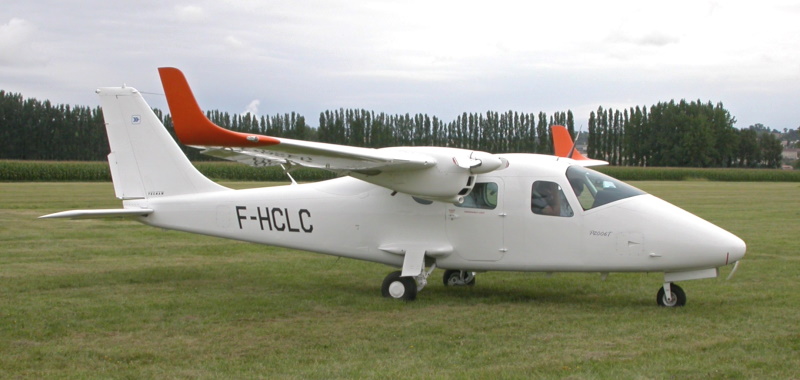
The wings were straight, with a single spar and winglets; the tailfin was swept, the tailplane was straight and all-moving. Flight control surfaces were conventional, including single-piece slotted flaps, ailerons, rudder, and trim tabs. Flaps were electrically actuated; the other flight control surfaces were manually actuated, using a pushrod scheme. There was an integral fuel tank in each wing outboard of the engine, total fuel capacity being 200 liters (53 US gallons).
All landing gear had single wheels and was electro-hydraulically actuated, the nose gear retracting forward, the main gear pivoting from sponsons into the fuselage. P2006T had a fuselage with a rounded-rectangle cross-section. It could carry three passengers and pilot, or 280 kilograms (618 pounds) of payload. There was a forward-hinged door on the front left, and a forward-hinged door on the rear right; there was a baggage hold behind the rear seats. A Garmin glass cockpit, with two large flat-panel displays, was available as an option.
___________________________________________________________________
TECNAM P2006T:
___________________________________________________________________
wingspan:
11.4 meters (37 feet 5 inches)
wing area:
14.75.2 sq_meters (158.8 sq_feet)
length:
8.69 meters (28 feet 6 inches)
height:
2.84 meters (9 feet 4 inches)
empty weight:
760 kilograms (1,675 pounds)
MTO weight:
1,180 kilograms (2,601 pounds)
cruise speed:
250 KPH (155 MPH / 135 KT)
service ceiling:
4,300 meters (14,000 feet)
range:
1,375 kilometers (855 MI / 740 NMI)
take-off distance (to 15 meters / 50 feet):
395 meters (1,295 feet)
landing distance (from 15 meters / 50 feet):
350 meters (1,145 feet)
___________________________________________________________________
* The Italian Air Force obtained a slightly-modifed "T2006A" for multi-engine pilot training. The P2006T has also been offered in two special-mission configurations:
The retractable landing gear configuration of the P2006T, which is not the norm for Tecnam aircraft, ensures a wide field of view for radar and other sensors.
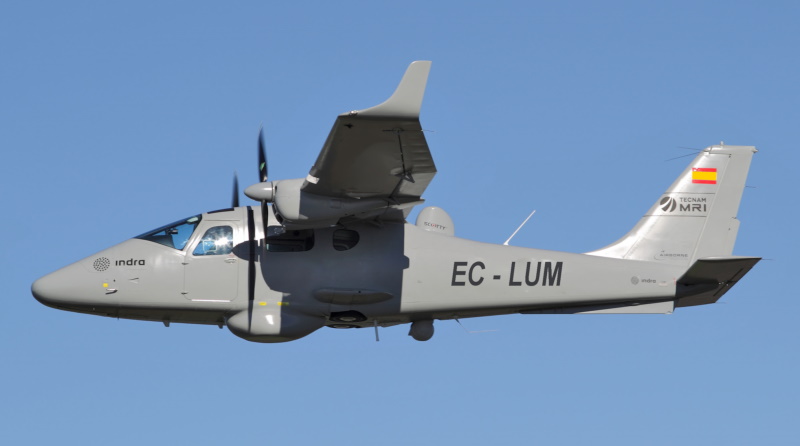
The most heavily modified P2006T was the "X-57 Maxwell", which was worked on by the US National Aeronautics & Space Administration (NASA) as a demonstrator for electric / electric-hybrid aircraft. The X-57 featured a new wing, replacing the twin Rotax engines with 14 electric motors -- including a large motor with a large prop on each wingtip, plus six small motors with small props inboard on each wing. Only the wingtip motors were used in cruise flight, with the props on the other motors being folded up. The wing didn't have winglets, and was narrower than the original wing; the multi-engine configuration was much more aerodynamically efficient than the original P2006T, and so it didn't need as much wing area.
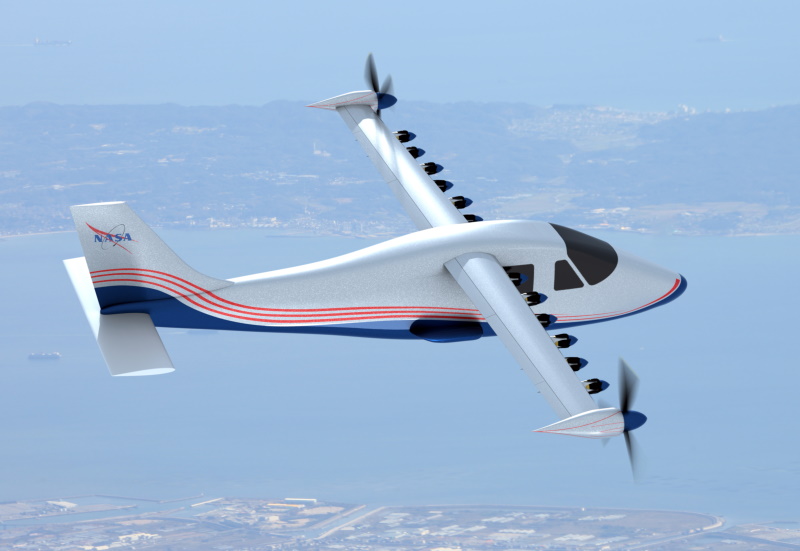
The X-57 was powered by a lithium-ion battery pack, giving it an endurance of an hour. The X-57 project was publicly announced in 2016; work was conducted in a series of test and development phases -- but the program bogged down, and was canceled in 2023.
BACK_TO_TOP* Working from the P2006T, Tecnam went on to develop a larger twin-engine machine, the "P2012 Traveller" -- the exercise being formed at the instigation of and in collaboration with Cape Air, a Massachusetts regional airline. Cape Air needed a new aircraft to replace their Cessna 402s. The first of three prototypes performed its initial flight on 21 July 2016.
As introduced, the P2012 was largely made of aircraft aluminum alloy, with some composite assemblies. It had a high cantilever wing, a straight tailplane mounted on the fuselage, and a swept tailfin. Flight control surfaces were conventional -- flaps, ailerons, elevators, rudder, with trim tabs, the flaps being electrically actuated, the other surfaces all manually controlled.
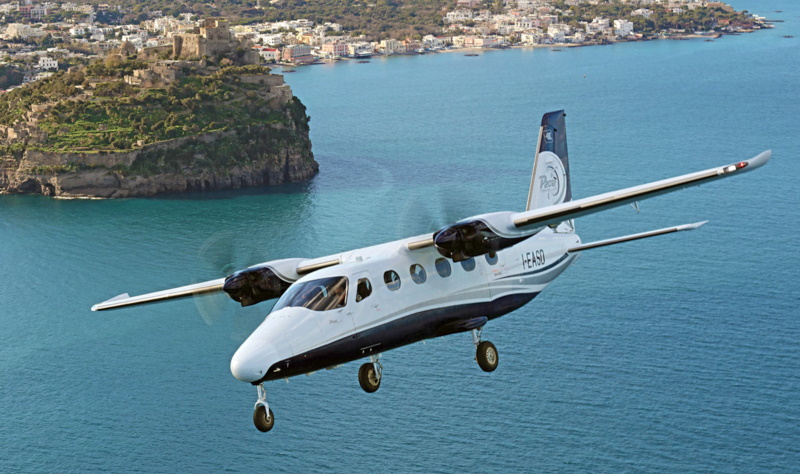
Each wing featured a Lycoming TEO540C1A flat-six air-cooled turbocharged engine, providing 280 kW (375 HP), driving three-bladed variable-pitch MT-Propeller props. The engines were fuel-injected and had electronic engine controls. There was an integral fuel tank in each wing, fuel capacity being 800 liters (212 US gallons). The P2012 had fixed tricycle landing gear, all gear with single wheels, the nose gear being steerable, the main gear being mounted on sponsons.
___________________________________________________________________
TECNAM P2012 TRAVELLER:
___________________________________________________________________
wingspan:
14 meters (45 feet 11 inches)
wing area:
35.4 sq_meters (273.7 sq_feet)
length:
11.8 meters (38 feet 7 inches)
height:
3.4 meters (14 feet 5 inches)
empty weight:
2,250 kilograms (4,960 pounds)
MTO weight:
3,600 kilograms (7,937 pounds)
cruise speed:
350 KPH (220 MPH / 190 KT)
service ceiling:
4,300 meters (14,000 feet)
range:
1,680 kilometers (1,045 MI / 910 NMI)
take-off distance (to 15 meters / 50 feet):
600 meters (1,970 feet)
landing distance (from 15 meters / 50 feet):
500 meters (1,640 feet)
___________________________________________________________________
The P2012 could be flown by one or two pilots, and had seats for nine passengers. It was unpressurized. Heating and ventilation were of course standard, with air-conditioning as an option. There were five flattened-oval passenger windows on each side of the fuselage. The P2102 had forward-hinged doors on each side of the cockpit, plus an elaborate dual door on the left rear fuselage: the forward half was split, with the lower half being an airstair when deployed, while the rear half hinged back for baggage / cargo loading.
Seats could be easily yanked for cargo carriage; executive, air ambulance, parachutist, and other specialized configurations could be accommodated as well. Dual controls were standard. The cockpit featured a Garmin dashboard with three large color displays. Weather radar was optional.
A "P2012 Sentinel Special Mission Platform (SMP)" variant was introduced in 2020, capable of being fitted with an electro-optic imager turret, a synthetic aperture radar, signals intelligence (SIGINT) gear, and so on. A "P2012 Short Take-Off / Landing (STOL)" variant, with high-lift devices, was introduced in 2012. Tecnam worked with Rolls-Royce on an all-electric derivative of the P2012, named the "P.Volt", but it was canceled.
BACK_TO_TOP* Tecnam also worked on a side-by-side jet trainer, the "P-Jet", with a single turbofan, mounted on the back, and twin tailfins. Not much has been said about it following its announcement in 2015.
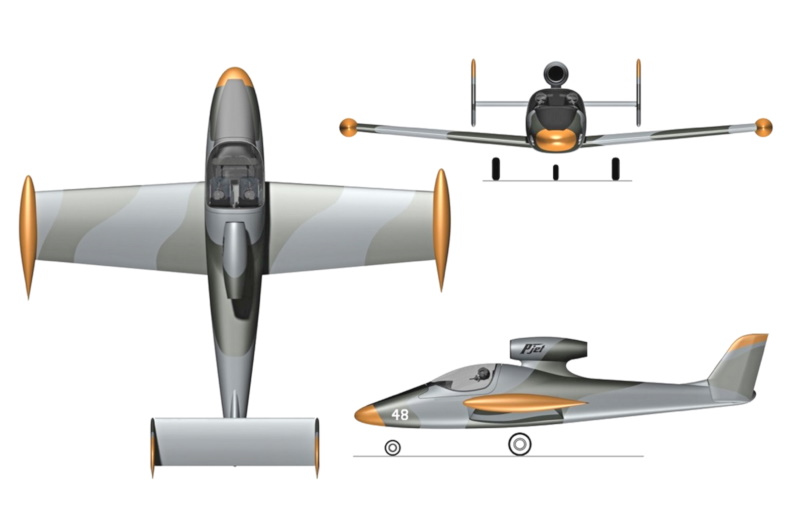
Sources for this document included volumes of JANE'S ALL THE WORLD'S AIRCRAFT back to the 1970s, plus the Vulcanair and Tecnam websites. These machines are not over-documented.
* Illustration credits:
* Revision history:
v1.0.0 / 01 feb 18 v1.1.0 / 01 feb 21 / Illustrations update. v1.2.0 / 01 jan 23 / P2012 SMP & STOL added. v1.2.1 / 01 dec 24 / More on X-57 Maxwell. (*)BACK_TO_TOP
